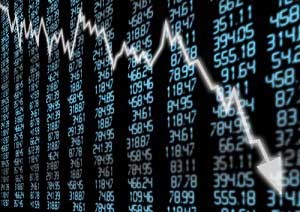All three major U.S. stock indexes dropped more than 2% this morning (Friday), prompting new fears of a stock market crash.
Another drop in oil prices and a sharp sell-off in Chinese stocks both contributed to the growing stock market crash fears on Friday.
 The Dow, the S&P 500, and the Nasdaq tumbled 2.34%, 2.3%, and 2.75%, respectively, minutes after Wall Street's opening bell. Crude oil plunged 5% to a 12-year low of $29.83. The 10-year Treasury saw its yield dipping below 2%.
The Dow, the S&P 500, and the Nasdaq tumbled 2.34%, 2.3%, and 2.75%, respectively, minutes after Wall Street's opening bell. Crude oil plunged 5% to a 12-year low of $29.83. The 10-year Treasury saw its yield dipping below 2%.
Disappointing U.S. economic data also contributed to the stock market crash fears:
- The Commerce Department said retail sales fell 0.1% in December. Excluding volatile autos and gasoline, sales were unchanged. Economists expected a 0.4% rise amid lower gasoline prices and an improving labor market.
- The Producer Price Index fell 0.2% in December after rising 0.3% in November. The read suggests inflation remains subdued.
- Industrial production for December fell 0.4%. Capacity utilization was 76.5% versus consensus estimates of 76.9%. November's read was revised downward to 76.9% from 77.0%.
The weak reports reinforced fears of economic growth in Q4. Economists forecast the U.S. economy grew just 1% or less in Q4. We had been seeing average growth near 2% during the six-and-a-half-year recovery.
Adding to the stock market crash angst Friday was the steep decline in Asian stocks. China's Shanghai Composite Index closed down 3.6% to enter bear-market territory, having lost 20% from a high in late December.
Money Morning Technical Trading Specialist D.R. Barton told FOX Business News this week the decline in stocks has been a measured move, and we could linger down here for a while. Barton added we shouldn't be surprised to see the Dow test lows near 15,370.
Here's what investors need to know now about a potential 2016 stock market crash, including how to protect your money...
How to Protect Your Money During a Stock Market Crash
We warned investors earlier this week that markets were on shaky ground when we highlighted the recent dismal data from the manufacturing sector.
You see, when an economy is heading towards recession, bleak data from the manufacturing sector typically signals the start.
And the manufacturing sector has been contracting for months. The latest readings indicate the worst manufacturing climate since March 2009, just as the economy was clawing its way out the depths of the Great Recession.
Money Morning Global Credit Strategist Michael Lewitt has been warning readers about these troubling signs in the markets for months.
Lewitt says damage from the commodities bubble, including the collapse of oil and commodities companies like Glencore Plc. (LON: GLEN), and the slowdown in China are just the beginning. That's because the global and U.S. financial systems are more leveraged than ever before.
U.S. nonfinancial corporations have 40% more net debt (debt net of cash) than they did in 2007, Lewitt explains. And seven years of near-zero interest rates coupled with several rounds of quantitative easing disguised "a lot of sins."
"They allowed China to play host to the biggest debt bubble in history," Lewitt said. "That bubble is now popping. And they allowed U.S. corporations to borrow more money than at any time before in history. Sooner or later markets get religion and sins get punished. That time is now."
And while the market may head lower in 2016, Lewitt says investors don't need to get caught off guard. In fact, he's written a complete guide on how to weather a potential $200 trillion credit collapse...
Stay informed on what's going on in the markets by following us on Twitter @moneymorning or liking us on Facebook.
Related Articles:
- CNBC: Dow Plunges 250 Points, Nasdaq Off 3% After Data, Oil Rout
- The Wall Street Journal: Stock Futures Point to Sharp U.S. Sell-Off Amid Global Rout
- The New York Times: Global Stock Markets Slide, Oil Falls Below $30 a Barrel
[mmpazkzone name="in-story" network="9794" site="307044" id="137008" type="4"]


